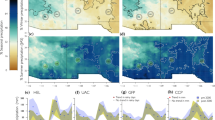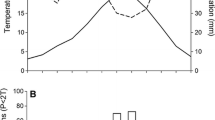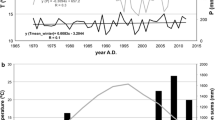Abstract
The ability of desert plants to adapt to future climate changes and maximize their water-use efficiency will determine their survival. This study uses wood anatomy and δ13C and δ18O isotope analyses to investigate how Moringa peregrina trees in the Egyptian desert have responded to the environment over the last 10 years. Our results show that M. peregrina tree-ring widths (TRWs) have generally declined over the last decade, although individual series are characterized by high variability and low Rbars. Vessel lumen area percentages (VLA%) are low in wet years but increase significantly in dry years, such as the period 2017–2020. Stable δ13C isotope values decrease between 2010 (− 23.4‰) and 2020 (− 24.9‰), reflecting an unexpected response to an increase in drought conditions. The mean δ18O value (± standard error, SE) for the first ten rings of each tree from bark to pith (2020–2010) is 33.0 ‰ ± 0.85 with a range of 29.2–36.3‰, which indicates a common drought signal. The intrinsic water-use efficiency (iWUE) declines gradually with time, from 130.0 µmol mol−1 in 2010 to 119.4 µmol mol−1 in 2020. The intercellular carbon concentration (Ci) and Ci/Ca ratio increase over the same period, likely as a result of decreasing iWUE. The results show that M. peregrina trees seem to cool their leaves and the boundary air at the cost of saving water.
Similar content being viewed by others
Data availability
All data generated or analyzed during this study are included in this published article and no supplementary files attached to the mns.
References
Al-Gohary I, Hajar A (1996) On the Ecology of Moringa peregrina (Forssk.) Fiori Anatomical Responses to Varying Soil Moisture Contents. Science (80-) 8:5–17
Altieri S, Mereu S, Cherubini P et al (2015) Tree-ring carbon and oxygen isotopes indicate different water use strategies in three Mediterranean shrubs at Capo Caccia (Sardinia, Italy). Trees - Struct Funct 29:1593–1603. https://doi.org/10.1007/s00468-015-1242-z
Azza SM (2014) Morpho-anatomical variations of leaves and seeds among three Moringa species. Life Sci J 11(10)
Bauters M, Meeus S, Barthel M et al (2020) Century-long apparent decrease in intrinsic water-use efficiency with no evidence of progressive nutrient limitation in African tropical forests. Glob Chang Biol 26:4449–4461. https://doi.org/10.1111/gcb.15145
Bertolino LT, Caine RS, Gray JE (2019) Impact of stomatal density and morphology on water-use efficiency in a changing world. Front Plant Sci 10:255. https://doi.org/10.3389/fpls.2019.00225
Blum A (2015) Towards a conceptual ABA ideotype in plant breeding for water limited environments. FPB 42(6):502–513. https://doi.org/10.1071/FP14334
Boulos L (1999) Flora of Egypt (Azollaceae-Oxalidaceae), vol. I. Al Hadara Publishing, Cairo, p 419
Brienen RJW, Schöngart J, Zuidema PA (2016) Tree rings in the tropics: insights into the ecology and climate sensitivity of tropical trees. In: Tropical tree physiology, pp 439–461
Canadell J, Zedler PH (1995) Underground structures of woody plants in Mediterranean ecosystems of Asutralia, California and Chile. In: Ecology and biogeography of Mediterranean ecosystems in Chile, California, and Australia. Springer, New York, NY, pp 177–210
Castagneri D, Regev L, Boaretto E, Carrer M (2017) Xylem anatomical traits reveal different strategies of two Mediterranean oaks to cope with drought and warming. Environ Exp Bot 133:128–138
Chaves MM, Costa JM, Zarrouk O et al (2016) Controlling stomatal aperture in semi-arid regions—The dilemma of saving water or being cool? Plant Sci 251:54–64. https://doi.org/10.1016/j.plantsci.2016.06.015
Choury Z, Shestakova TA, Himrane H, Touchan R (2017) Quarantining the Sahara desert : growth and water-use efficiency of Aleppo pine in the Algerian Green Barrier. Eur J for Res 136:139–152. https://doi.org/10.1007/s10342-016-1014-3
Colombaroli D, Cherubini P, De Ridder M et al (2016) Stable carbon and oxygen isotopes in tree rings show physiological responses of Pericopsis elata to precipitation in the Congo Basin. J Trop Ecol 32:213–225. https://doi.org/10.1017/S0266467416000134
Driscoll AW, Bitter NQ, Sandquist DR, Ehleringer JR (2020) Multidecadal records of intrinsic water-use efficiency in the desert shrub Encelia farinosa reveal strong responses to climate change. Proc Natl Acad Sci 117:18161–18168
Farahat E, Gärtner H (2019) Dendrochronologia Anatomy and dendrochronological potential of Moringa peregrina from the hyper-arid desert in Egypt. Dendrochronologia 56:125606. https://doi.org/10.1016/j.dendro.2019.125606
Farquhar GD, Richards RA (1984) Isotopic composition of plant carbon correlates with water-use efficiency of wheat genotypes. Funct Plant Biol 11:539–552
Farquhar GD, O'Leary MH, Berry JA (1982) On the relationship between carbon isotope discrimination and the intercellular carbon dioxide concentration in leaves. Funct Plant Bio 9(2):121–137
Ferrio JP, Voltas J (2005a) Carbon and oxygen isotope ratios in wood constituents of Pinus halepensis as indicators of precipitation, temperature and vapour pressure deficit. Tellus, Ser B Chem Phys Meteorol 57:164–173. https://doi.org/10.1111/j.1600-0889.2005.00137.x
Ferrio JP, Voltas J (2005b) Carbon and oxygen isotope ratios in wood constituents of Pinus halepensis as indicators of precipitation, temperature and vapour pressure deficit. Tellus B Chem Phys Meteorol 57:164–173. https://doi.org/10.3402/tellusb.v57i2.16780
Fonti P, von Arx G, García-González I et al (2010) Studying global change through investigation of the plastic responses of xylem anatomy in tree rings. New Phytol 185:42–53
Galle A, Esper J, Feller U, et al (2010) Responses of wood anatomy and carbon isotope composition of Quercus pubescens saplings subjected to two consecutive years of summer drought. Ann For Sci 67(8):809
Gargallo-Garriga A, Sardans J, Pérez-Trujillo M, Rivas-Ubach A, Oravec M, Vecerova K, ... , Peñuelas J (2014) Opposite metabolic responses of shoots and roots to drought. Sci Rep 4:1–7
Gärtner H, Lucchinetti S, Schweingruber FH (2015) A new sledge microtome to combine wood anatomy and tree-ring ecology. IAWA J 36:452–459. https://doi.org/10.1163/22941932-20150114
Gebauer R, Plichta R, Urban J et al (2020) The resistance and resilience of European beech seedlings to drought stress during the period of leaf development. Tree Physiol 40:1147–1164. https://doi.org/10.1093/treephys/tpaa066
Green JW (1963) Wood cellulose. In: Whistler RL (ed) Methods of carbohydrate chemistry, pp 9–12
Harris I, Osborn TJ, Jones P, Lister D (2020) Version 4 of the CRU TS monthly high-resolution gridded multivariate climate dataset. Sci Data 7:1–18
Heinrich I, Gärtner H (2008) Variations in tension wood of two broad-leaved tree species in response to different mechanical treatments: implications for dendrochronology and mass movement studies. Int J Plant Sci 169:928–936
Heinrich I, Gärtner H, Monbaron M (2007) Tension wood formed in Fagus sylvatica and Alnus glutinosa after simulated mass movement events. IAWA J 28:39–48
Huang J, Yu H, Guan X et al (2016) Accelerated dryland expansion under climate change. Nat Clim Chang 6:166–171. https://doi.org/10.1038/nclimate2837
Lange O (1959) Studies on the heat balance and heat resistance of Mauritanian desert and savanna plants. Flora, Jena 147:595–651
Levanič T, Jevšenak J, Hafner P (2020) Stable Isotopes Reveal Climate Signal Hidden in Tree Rings of Endemic Balkan Pines. Atmosphere (Basel) 11:135
Lukač L, Mikac S, Urban O et al (2021) Stable Isotopes in Tree Rings of Pinus heldreichii Can Indicate Climate Variability over the Eastern Mediterranean Region. Forests 12:350
Ma WT, Tcherkez G, Wang XM et al (2020) Accounting for mesophyll conductance substantially improves 13 C‐based estimates of intrinsic water‐use efficiency. New Phytol 229(3): 326–1338
McCarroll D, Loader NJ (2004) Stable isotopes in tree rings. Quat Sci Rev 23:771–801
Moulin M, Mossou E, Signor L et al (2019) Towards a molecular understanding of the water purification properties of Moringa seed proteins. J Colloid Interface Sci 554:296–304
Nouhi S, Kwaambwa HM, Gutfreund P, Rennie AR (2019) Comparative study of flocculation and adsorption behaviour of water treatment proteins from Moringa peregrina and Moringa oleifera seeds. Sci Rep 299(1):17945. https://doi.org/10.1038/s41598-019-54069-2
Novick KA, Ficklin DL, Stoy PC et al (2016) The increasing importance of atmospheric demand for ecosystem water and carbon fluxes. Nat Clim Chang 6:1023–1027
Olano JM, Linares JC, García-Cervigón AI et al (2014) Drought-induced increase in water-use efficiency reduces secondary tree growth and tracheid wall thickness in a Mediterranean conifer. Oecologia 176:273–283. https://doi.org/10.1007/s00442-014-2989-4
Olson ME, Carlquist S (2001) Stem and root anatomical correlations with life form diversity, ecology, and systematics in Moringa (Moringaceae). Bot J Linn Soc 135:315–348
Olson EJ, Dodd JP, Rivera MA (2020) Prosopis sp tree-ring oxygen and carbon isotope record of regional-scale hydroclimate variability during the last 9500 years in the Atacama Desert. Palaeogeogr, Palaeoclimatol, Palaeoecol 538:109408
Panayotov M, Tsavkov E, Zhelev P et al (2011) tree ring and anatomical studies in pinus held-reichii forests in pirin mountains, Bulgaria. For Ideas 17:66–73
Pellizzari E, Camarero JJ, Gazol A et al (2016) Wood anatomy and carbon-isotope discrimination support long-term hydraulic deterioration as a major cause of drought-induced dieback. Glob Chang Biol 22:2125–2137. https://doi.org/10.1111/gcb.13227
Qin C, Yang B, Bräuning A et al (2015) Drought signals in tree-ring stable oxygen isotope series of Qilian juniper from the arid northeastern Tibetan Plateau. Glob Planet Change 125:48–59. https://doi.org/10.1016/j.gloplacha.2014.12.002
Rahman M, Islam M, Gebrekirstos A, Bräuning A (2019a) Trends in tree growth and intrinsic water-use efficiency in the tropics under elevated CO 2 and climate change. Trees - Struct Funct 33:623–640. https://doi.org/10.1007/s00468-019-01836-3
Rahman M, Islam M, Gebrekirstos A, Bräuning A (2019b) Trends in tree growth and intrinsic water-use efficiency in the tropics under elevated CO 2 and climate change. Trees - Struct Funct 623–640. https://doi.org/10.1007/s00468-019-01836-3
Sabella E, Moretti S, Gärtner H et al (2020) Increase in ring width, vessel number and δ18O in olive trees infected with Xylella fastidiosa. Tree Physiol 40:1583–1594
Santiago LS, Silvera K, Andrade JL, Dawson TE (2017) Functional strategies of tropical dry forest plants in relation to growth form and isotopic composition. Environ Res Lett 12(11):115006
Sarris D, Siegwolf R, Körner C (2013) Inter- and intra-annual stable carbon and oxygen isotope signals in response to drought in Mediterranean pines. Agric for Meteorol 168:59–68. https://doi.org/10.1016/j.agrformet.2012.08.007
Saurer M, Spahni R, Frank DC et al (2014) Spatial variability and temporal trends in water-use efficiency of European forests. Glob Chang Biol 20:3700–3712. https://doi.org/10.1111/gcb.12717
Scheidegger Y, Saurer M, Bahn M, Siegwolf R (2000) Linking stable oxygen and carbon isotopes with stomatal conductance and photosynthetic capacity: A conceptual model. Oecologia 125:350–357. https://doi.org/10.1007/s004420000466
Schuldt B, Knutzen F, Delzon S et al (2016) How adaptable is the hydraulic system of European beech in the face of climate change-related precipitation reduction? New Phytol 210:443–458
Seibt U, Rajabi A, Griffiths H, Berry JA (2008) Carbon isotopes and water use efficiency: Sense and sensitivity. Oecologia 155(3):441–454
Sevanto S, Mcdowell NG, Dickman LT et al (2014) How do trees die? A test of the hydraulic failure and carbon starvation hypotheses. Plant Cell Environ 37:153–161
Smith WK (1978) Temperatures of Desert Plants: Another Perspective on the Adaptability of Leaf Size. Science (80- ) 201:614 LP – 616. https://doi.org/10.1126/science.201.4356.614
Treydte K, Boda S, Graf Pannatier E et al (2014) Seasonal transfer of oxygen isotopes from precipitation and soil to the tree ring: source water versus needle water enrichment. New Phytol 202:772–783
Volkmann THM, Haberer K, Gessler A, Weiler M (2016) High-resolution isotope measurements resolve rapid ecohydrological dynamics at the soil–plant interface. New Phytol 210:839–849
Wieloch T, Helle G, Heinrich I et al (2011) A novel device for batch-wise isolation of α-cellulose from small-amount wholewood samples. Dendrochronologia 29:115–117
Wigley TML, Briffa KR, Jones PD (1984) On the average value of correlated time series, with applications in dendroclimatology and hydrometeorology. J Clim Appl Meteorol 23:201–213
Wilson R, Wilson D, Rydval M et al (2017) Facilitating tree-ring dating of historic conifer timbers using Blue Intensity. J Archaeol Sci 78:99–111. https://doi.org/10.1016/j.jas.2016.11.011
Woodley EJ, Loader NJ, McCarroll D et al (2012) High-temperature pyrolysis/gas chromatography/isotope ratio mass spectrometry: simultaneous measurement of the stable isotopes of oxygen and carbon in cellulose. Rapid Commun Mass Spectrom 26:109–114
Worbes M (1995) How to measure growth dynamics in tropical trees a review. IAWA J 16:337–351
Xu C, Sano M, Nakatsuka T (2011) Tree ring cellulose δ18O of Fokienia hodginsii in northern Laos: A promising proxy to reconstruct ENSO? J Geophys Res Atmos 116(D24)
Youssef AM, Pradhan B, Hassan AM (2011) Flash flood risk estimation along the St. Katherine road, southern Sinai, Egypt using G0049S based morphometry and satellite imagery. Environ Earth Sci 62:611–623. https://doi.org/10.1007/s12665-010-0551-1
Ziaco E, Biondi F, Heinrich I (2016) Wood cellular dendroclimatology: Testing new proxies in great basin bristlecone pine. Front Plant Sci 7:1–13. https://doi.org/10.3389/fpls.2016.01602
Acknowledgements
We thank Nadja Studer for her kind help in preparing the wood samples for anatomical and isotopic measurements.
Funding
Funding for this study was provided by the Swiss National Science Foundation (SNSF) for EF and HG (SNSF, grant Nr. IZSEZ0_192144 / 1, 2019).
Author information
Authors and Affiliations
Contributions
Emad Farahat: Conceptualization, investigation, methodology, formal analysis, software, writing (original draft), and writing (review and editing). Paolo Cherubini: Methodology, review, and editing. Matthias Saurer: Methodology, review, and editing. Holger Gärtner: Conceptualization, methodology, and writing (review and editing).
Corresponding author
Ethics declarations
Ethics approval
Field studies were carried out according to the Egyptian legislation.
Consent to participate
Not applicable.
Consent for publication
Not applicable.
Conflict of interest
The authors declare no competing interests.
Rights and permissions
About this article
Cite this article
Farahat, E., Cherubini, P., Saurer, M. et al. Wood anatomy and tree-ring stable isotopes indicate a recent decline in water-use efficiency in the desert tree Moringa peregrina. Int J Biometeorol 66, 127–137 (2022). https://doi.org/10.1007/s00484-021-02198-7
Received:
Revised:
Accepted:
Published:
Issue Date:
DOI: https://doi.org/10.1007/s00484-021-02198-7










